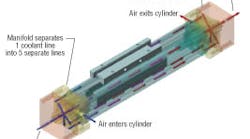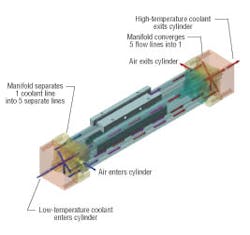Rodless cylinder takes the heat
To develop this actuator, engineers at Hoerbiger-Origa had taken the company's basic OSP rodless-style cylinder and extruded five equally spaced, longitudinal passages in the wall of its barrel, parallel with its centerline. The plan was to flow coolant through the endcaps into these passages, thus using conduction to hold the cylinder's internal temperature to a safe level.
To prevent coolant leakage, special high-temperature gaskets were placed between the cylinder's endcaps and barrel. To deliver coolant to the barrel cavities, the designers modified the endcaps and their mounting screws, and developed special manifolds that attach directly to each endcap's outboard face. With this arrangement, coolant arrives at a single port in the manifold block, is separated internally and directed to the five passages through the barrel. Another manifold at the opposite end recombines the coolant streams, which then exit from another single port. (As in the original OSP design, compressed air enters and exits the OSP-P cylinder through ports in the sides of the end caps.)
In the final Thermocylinder installation, coolant is pumped into each barrel cavity via one manifold and flows through the entire length of the cylinder. As the fluid travels, it absorbs the higher heat energy (through forced convection) from the outer wall of the cylinder and carries it away. The barrel behaves similarly to a water jacket, keeping the bore of the cylinder, along with its rubber and plastic parts, cool and unaffected by the outside temperatures. The heated fluid exits the cylinder through the second manifold and is piped to a heat exchanger/blower system. The heat exchanger/blower system expels the collected heat energy carried in the fluid out into the atmosphere, lowering the fluid's temperature. The cooled fluid leaves the heat exchanger and is pumped back into the cylinder where the process is repeated.
If a 1.5-in. bore OSP-P Thermocylinders with a 72-in. stroke was installed to scrape excess hot material from an extruder head, Hoerbiger-Origa estimates that its cooling arrangement can remove about 10,000 Btu/hr of thermal energy, more than enough to keep the cylinder cycling around the clock.
For more information, contact Hoerbiger-Origa at (630) 871-8300 or vist www.hoerbiger-origa.com.


